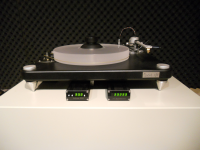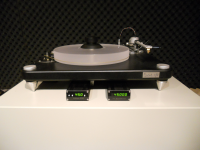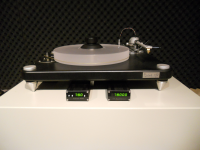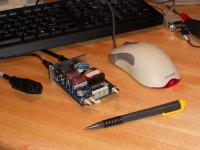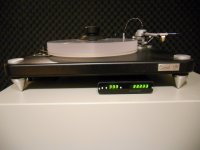Moreover, the hex file is accessible on the microcontroller anyway if you have the interface in the first place.
This is where I fall short understanding what is the problem with the .hex file.
It is not accessible on a protected device. And it's not easy to bust the protection.
Or are you just playing stupid?
oh, you are saying that he set up the combination lock up code on the registers of the uC so that I can upload nor read the .hex file on the memory?
I think it is a little bit excessive but I can understand why he set it up for protection!
Like I said, it's totally fine with me if he develops an update to buy the programmed uC.

I think it is a little bit excessive but I can understand why he set it up for protection!
Like I said, it's totally fine with me if he develops an update to buy the programmed uC.
33 45 78 RPM Turntable Power Supply
Stefano-
If you're not in a hurry to get your table going with Meldano's design (or upgrade), you might want to give a look at the PSU and tachometer I've been working on.....
It will do 33, 45 and 78 RPM with one pulley and without moving the belt. It is DDS based so I can control the frequency output in 35µHz steps; this comes in handy when it is connected to the digital tachometer which feeds back the speed info to the PSU every rev and the PSU can make micro adjustments to keep the speed locked on to within ±0.005 RPM at any speed (even if you change the tempo by moving to say, 33.5). It reduces the voltage after the platter reaches speed and has a calibration mode for fine tuning each speed if you don't use the tach (has 0.01RPM steps instead of 0.1RPM). It has separate adjustments for reduced voltage for each of the 3 speeds.
The package in the pics is quite small (2.5" x 3.5" x 1.2") so I wasn't able to do a dual phase version because of the heat dissipation, but I'm looking at a larger version that will have dual phase outputs. I have prototype versions that will do 16-24VAC and one that does 120/240VAC.
All of the adjustments-- speed, voltage and phase are accessible from the front panel (no PC needed) and are stored in an internal EEPROM.
All of them are pre-production, but pending a couple of decisions that need to be made, they could be available by early 2Q14.
From your location, do you spend time in the US (WI)?
Stefano-
If you're not in a hurry to get your table going with Meldano's design (or upgrade), you might want to give a look at the PSU and tachometer I've been working on.....
It will do 33, 45 and 78 RPM with one pulley and without moving the belt. It is DDS based so I can control the frequency output in 35µHz steps; this comes in handy when it is connected to the digital tachometer which feeds back the speed info to the PSU every rev and the PSU can make micro adjustments to keep the speed locked on to within ±0.005 RPM at any speed (even if you change the tempo by moving to say, 33.5). It reduces the voltage after the platter reaches speed and has a calibration mode for fine tuning each speed if you don't use the tach (has 0.01RPM steps instead of 0.1RPM). It has separate adjustments for reduced voltage for each of the 3 speeds.
The package in the pics is quite small (2.5" x 3.5" x 1.2") so I wasn't able to do a dual phase version because of the heat dissipation, but I'm looking at a larger version that will have dual phase outputs. I have prototype versions that will do 16-24VAC and one that does 120/240VAC.
All of the adjustments-- speed, voltage and phase are accessible from the front panel (no PC needed) and are stored in an internal EEPROM.
All of them are pre-production, but pending a couple of decisions that need to be made, they could be available by early 2Q14.
From your location, do you spend time in the US (WI)?
Attachments
Stefano-
If you're not in a hurry to get your table going with Meldano's design (or upgrade), you might want to give a look at the PSU and tachometer I've been working on.....
It will do 33, 45 and 78 RPM with one pulley and without moving the belt. It is DDS based so I can control the frequency output in 35µHz steps; this comes in handy when it is connected to the digital tachometer which feeds back the speed info to the PSU every rev and the PSU can make micro adjustments to keep the speed locked on to within ±0.005 RPM at any speed (even if you change the tempo by moving to say, 33.5). It reduces the voltage after the platter reaches speed and has a calibration mode for fine tuning each speed if you don't use the tach (has 0.01RPM steps instead of 0.1RPM). It has separate adjustments for reduced voltage for each of the 3 speeds.
The package in the pics is quite small (2.5" x 3.5" x 1.2") so I wasn't able to do a dual phase version because of the heat dissipation, but I'm looking at a larger version that will have dual phase outputs. I have prototype versions that will do 16-24VAC and one that does 120/240VAC.
All of the adjustments-- speed, voltage and phase are accessible from the front panel (no PC needed) and are stored in an internal EEPROM.
All of them are pre-production, but pending a couple of decisions that need to be made, they could be available by early 2Q14.
From your location, do you spend time in the US (WI)?
Hi thank you very much for your input.
No, I am not in hurry, like I said I am working on a couple of prototypes for new gears I am developing.
If you make a dual phase with phase control for each individual speed, please sign me in. 24V motor would be perfect. You can substitute your 120V hurst Motor with the 24V equivalent version which I am sure has even little less vibration due to lower operating voltage.
When do you think you will have a finished version for the dual phase?

24V Turntable Motor Supply
Stefano-
The only version I have that will do dual phase output right now is a prototype with both the PSU and the tach in one package. The 120V version ran a little warm (~50°C after 1 hour continuous operation), but I think the 24V amp runs a little cooler. If you are interested, I could build one up in the next couple of weeks.
Stefano-
The only version I have that will do dual phase output right now is a prototype with both the PSU and the tach in one package. The 120V version ran a little warm (~50°C after 1 hour continuous operation), but I think the 24V amp runs a little cooler. If you are interested, I could build one up in the next couple of weeks.
Attachments
Interested as well ...
Pyramid - I am awed and amazed about what you've put together here. I've viewed your posts on the related threads (re: tachometer and motor controller) and would like to follow where this takes you, whether to commercial production or something else. Personally would love to procure one for my LP-12! Please pm me! Thanks.
Pyramid - I am awed and amazed about what you've put together here. I've viewed your posts on the related threads (re: tachometer and motor controller) and would like to follow where this takes you, whether to commercial production or something else. Personally would love to procure one for my LP-12! Please pm me! Thanks.
Help! I am very confused by this thread. I think I understand what you guys are doing, but I really don't understand why.
I believe most of the VPI turntables use Hurst AC synchronous motors, 115V. I have purchased the SAMA motor module, taken it apart, it is also a Hurst synchronous motor. Within the same 115V 300 or 600 rpm family, Hurst offers several motors of different torque ratings. Even with the same form factor there are several torque options available. The motors even come with the correct corresponding capacitor for phase shift and wiring diagram.
But, these motors have very cheap bronze bushing bearings that are noisy and I would think not very good for a rim drive. The VPI SAMA motor has an obvious noise or rattle when the bushing slides just a bit up the shaft. Easily made quiet again by bumping the bushing back but obviously a noise prone bushing.
I've searched and cannot find a better built motor, but I would think the most fruitful approach would be to just get a higher torque Hurst motor and replace the bronze bushing with a precision glass reinforced teflon bushing from Igus (if they have the right size, and if it's possible to rebuild the motor). And then just use any old frequency drive.
Why change to 24V? There are several 115V after market synchronous power supplies available. Music Hall Cruise Control 2.0 Speed Controller
Is there any technical reason why 24V is better? Why not stay with the 115V synchronous and be able to use one of several stock synchronous drives.
If the Hurst motors don't drive well with a belt, why would they drive better with a makeshift idler wheel? If the motor has low enough vibration why not just replace the belt with something that doesn't have whatever property you don't like? Is the belt too elastic? Get a stiffer belt. But, of course a stiffer belt will transfer noise from the noisy motor. And, we are back where we started.
I'm really curious as to how to find better motors as it was very disappointing to see the really cheap motors VPI uses. I would have bought the SAMA's just to use the motors, but since they're just $100 Hurst motors, what's the point? I suspect that better options just don't exist except for very rare or expensive motors that are custom made or borrowed from more exotic applications.
I was really hoping you guys had found a new motor source for AC synchronous motors, but after ready through the thread I'm totally lost as to what you're trying to accomplish. Help!
I believe most of the VPI turntables use Hurst AC synchronous motors, 115V. I have purchased the SAMA motor module, taken it apart, it is also a Hurst synchronous motor. Within the same 115V 300 or 600 rpm family, Hurst offers several motors of different torque ratings. Even with the same form factor there are several torque options available. The motors even come with the correct corresponding capacitor for phase shift and wiring diagram.
But, these motors have very cheap bronze bushing bearings that are noisy and I would think not very good for a rim drive. The VPI SAMA motor has an obvious noise or rattle when the bushing slides just a bit up the shaft. Easily made quiet again by bumping the bushing back but obviously a noise prone bushing.
I've searched and cannot find a better built motor, but I would think the most fruitful approach would be to just get a higher torque Hurst motor and replace the bronze bushing with a precision glass reinforced teflon bushing from Igus (if they have the right size, and if it's possible to rebuild the motor). And then just use any old frequency drive.
Why change to 24V? There are several 115V after market synchronous power supplies available. Music Hall Cruise Control 2.0 Speed Controller
Is there any technical reason why 24V is better? Why not stay with the 115V synchronous and be able to use one of several stock synchronous drives.
If the Hurst motors don't drive well with a belt, why would they drive better with a makeshift idler wheel? If the motor has low enough vibration why not just replace the belt with something that doesn't have whatever property you don't like? Is the belt too elastic? Get a stiffer belt. But, of course a stiffer belt will transfer noise from the noisy motor. And, we are back where we started.
I'm really curious as to how to find better motors as it was very disappointing to see the really cheap motors VPI uses. I would have bought the SAMA's just to use the motors, but since they're just $100 Hurst motors, what's the point? I suspect that better options just don't exist except for very rare or expensive motors that are custom made or borrowed from more exotic applications.
I was really hoping you guys had found a new motor source for AC synchronous motors, but after ready through the thread I'm totally lost as to what you're trying to accomplish. Help!
For what it's worth, a bit more on the motor ideas.
I believe most of the AC Synchronous motors VPI uses are in the Hurst PA, PB direct drive AC synchronous motor family. They may use both the 300 rpm and 600 rpm variants, but all are 60 hz AC synchronous motors with the same form factor. As an aside, I was not able to find the exact model number motor I found in the VPI SAMA on the Hurst website and I am speculating that it is not really any different than the stock available motors, but I have no proof of that.
See the webpage here and you can see several different torque ratings all for the same form factor motor. They all weigh the same, same bolt pattern, same shaft, etc. The actual drive wattage changes only slightly so I don't see why you couldn't use the same power supply accross the family of motors, and of course most of the time in the US at least that power supply is just plugging into the wall outlet, since they are AC synchronous to 60 hz.
PA, PB Direct Drive Permanent Magnet AC Synchronous Motors
But now as an idea for more torque, but still the same AC synchronous idea, checkout the RA series motors. A bit larger form factor, a bit more power requirement, but not much. Also notice the shaft is now larger, 6.35mm dia. and available in a bushed or bearing configuration. I'd assuming bearings are noisy, and the bushed shaft should be more substantial for rim driving.
RA Direct Drive Permanent Magnet AC Synchronous Motors
Now, what I find most interesting as an opportunity to improve these motors is to swap out the bronze bushings for a teflon bearing. I don't like all these bronze bearings in turntables, but I don't really have a good reason for that or any experience to back it up.
igus is a technical leader in plastic bushings. The iglide J material appears to have the lowest coefficient of friction to steel shafts and the broadest application. I think there is a good possibility that the cheap bronze bushings in the Hurst motors could be swapped out for iglide J bushings resulting in a quieter motor better suited to rim drive. As a DIY material the plastic bushings should be easy to work with even if some machining would be required. The installation of a plastic bushing is also clever. The bushing doesn't reach it's final toleranced I.D. until it is pressed in place. This might require experimentation but you can imagine that you can tune the fitment of the bushing to the shaft to get the least play without too much friction. In all these bronze bushings there is plenty of play left in the bearing that then must be filled with lubricant for the bearing to work properly. It's really obsolete bearing technology.
igus® Plastic Plain Bearings: iglide® J
I might try to take apart one of these Hurst motors to see what I can find. If there's a one for one swap of bronze bushing with iglide it could be a great DIY upgrade to the motors. The noise of the VPI SAMA motor is really noticeable and has been reported in other forums. It's easy enough to fix, but obviously the motor is not optimized for audio.
I believe most of the AC Synchronous motors VPI uses are in the Hurst PA, PB direct drive AC synchronous motor family. They may use both the 300 rpm and 600 rpm variants, but all are 60 hz AC synchronous motors with the same form factor. As an aside, I was not able to find the exact model number motor I found in the VPI SAMA on the Hurst website and I am speculating that it is not really any different than the stock available motors, but I have no proof of that.
See the webpage here and you can see several different torque ratings all for the same form factor motor. They all weigh the same, same bolt pattern, same shaft, etc. The actual drive wattage changes only slightly so I don't see why you couldn't use the same power supply accross the family of motors, and of course most of the time in the US at least that power supply is just plugging into the wall outlet, since they are AC synchronous to 60 hz.
PA, PB Direct Drive Permanent Magnet AC Synchronous Motors
But now as an idea for more torque, but still the same AC synchronous idea, checkout the RA series motors. A bit larger form factor, a bit more power requirement, but not much. Also notice the shaft is now larger, 6.35mm dia. and available in a bushed or bearing configuration. I'd assuming bearings are noisy, and the bushed shaft should be more substantial for rim driving.
RA Direct Drive Permanent Magnet AC Synchronous Motors
Now, what I find most interesting as an opportunity to improve these motors is to swap out the bronze bushings for a teflon bearing. I don't like all these bronze bearings in turntables, but I don't really have a good reason for that or any experience to back it up.
igus is a technical leader in plastic bushings. The iglide J material appears to have the lowest coefficient of friction to steel shafts and the broadest application. I think there is a good possibility that the cheap bronze bushings in the Hurst motors could be swapped out for iglide J bushings resulting in a quieter motor better suited to rim drive. As a DIY material the plastic bushings should be easy to work with even if some machining would be required. The installation of a plastic bushing is also clever. The bushing doesn't reach it's final toleranced I.D. until it is pressed in place. This might require experimentation but you can imagine that you can tune the fitment of the bushing to the shaft to get the least play without too much friction. In all these bronze bushings there is plenty of play left in the bearing that then must be filled with lubricant for the bearing to work properly. It's really obsolete bearing technology.
igus® Plastic Plain Bearings: iglide® J
I might try to take apart one of these Hurst motors to see what I can find. If there's a one for one swap of bronze bushing with iglide it could be a great DIY upgrade to the motors. The noise of the VPI SAMA motor is really noticeable and has been reported in other forums. It's easy enough to fix, but obviously the motor is not optimized for audio.
AC Synchronous Motor Controller
Jnoneiliv1-
You raise some good points in your two posts. There is certainly more than one area where improvement could be made in off-the-shelf turntable design. I think this thread is focusing on motor vibration as a matter of degree. While the bearing may contribute to motor induced noise, the amount of noise is small compared to the vibration created by the motor. While the difference in vibration between 115VAC and 24VAC motors is also a subject of debate (I'll defer to those who have seen results in going to a lower voltage motor), there is certainly substantial evidence that 300RPM vs 600RPM motors produce lower vibration (twice the pole pairs, less cogging).
As for the motor supply, the AC line voltage from the wall is accurate over time, but can experience short term fluctuations in frequency and phase, not to mention, it is notoriously noisy and susceptible to surges created within the listeners own environment (I've noticed the speed change, using the digital tach, when the air conditioner kicks in). The regenerative PSU remedies most of these problems. The MH Cruise Control is a cheap and cheerful example, but is woefully under-powered (you have to start it at 33 RPM to play 45 RPM records) and not very accurate; it uses PWM to generate the sinewave which has horrible resolution (at 33.3 RPM setting, the frequency is off by ~.3%) and mediocre distortion (~5%). Of all the commercially available motor supply circuits I've been able to get my hands on, it appears mine will be the only one using DDS technology (35µHz frequency steps, <.1° phase steps, <0.3% distortion) and is definitely the only one that can be synched to an accurate, high resolution measuring device (digital tachometer). It is not meant to be a cure-all for what ails your turntable (it doesn't address wow and flutter or bearing induced noise, tracking error, etc.) it makes a significant step in the right direction.
Jnoneiliv1-
You raise some good points in your two posts. There is certainly more than one area where improvement could be made in off-the-shelf turntable design. I think this thread is focusing on motor vibration as a matter of degree. While the bearing may contribute to motor induced noise, the amount of noise is small compared to the vibration created by the motor. While the difference in vibration between 115VAC and 24VAC motors is also a subject of debate (I'll defer to those who have seen results in going to a lower voltage motor), there is certainly substantial evidence that 300RPM vs 600RPM motors produce lower vibration (twice the pole pairs, less cogging).
As for the motor supply, the AC line voltage from the wall is accurate over time, but can experience short term fluctuations in frequency and phase, not to mention, it is notoriously noisy and susceptible to surges created within the listeners own environment (I've noticed the speed change, using the digital tach, when the air conditioner kicks in). The regenerative PSU remedies most of these problems. The MH Cruise Control is a cheap and cheerful example, but is woefully under-powered (you have to start it at 33 RPM to play 45 RPM records) and not very accurate; it uses PWM to generate the sinewave which has horrible resolution (at 33.3 RPM setting, the frequency is off by ~.3%) and mediocre distortion (~5%). Of all the commercially available motor supply circuits I've been able to get my hands on, it appears mine will be the only one using DDS technology (35µHz frequency steps, <.1° phase steps, <0.3% distortion) and is definitely the only one that can be synched to an accurate, high resolution measuring device (digital tachometer). It is not meant to be a cure-all for what ails your turntable (it doesn't address wow and flutter or bearing induced noise, tracking error, etc.) it makes a significant step in the right direction.
- Home
- Source & Line
- Analogue Source
- Motor for turntable
